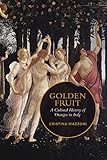Golden Fruit : A Cultural History of Oranges in Italy / Christina Mazzoni.
Material type: TextSeries: Toronto Italian StudiesPublisher: Toronto : University of Toronto Press, [2018]Copyright date: ©2018Description: 1 online resource (224 p.)Content type:
TextSeries: Toronto Italian StudiesPublisher: Toronto : University of Toronto Press, [2018]Copyright date: ©2018Description: 1 online resource (224 p.)Content type: - 9781487502669
- 9781487515768
- 641.3/431
- SB370.O7 M39 2018
- online - DeGruyter
| Item type | Current library | Call number | URL | Status | Notes | Barcode | |
|---|---|---|---|---|---|---|---|
 eBook
eBook
|
Biblioteca "Angelicum" Pont. Univ. S.Tommaso d'Aquino Nuvola online | online - DeGruyter (Browse shelf(Opens below)) | Online access | Not for loan (Accesso limitato) | Accesso per gli utenti autorizzati / Access for authorized users | (dgr)9781487515768 |
Browsing Biblioteca "Angelicum" Pont. Univ. S.Tommaso d'Aquino shelves, Shelving location: Nuvola online Close shelf browser (Hides shelf browser)

|

|

|

|

|

|

|
||
| online - DeGruyter Ukrainian Epic and Historical Song : Folklore in Context / | online - DeGruyter Sovereignty's Entailments : First Nation State Formation in the Yukon / | online - DeGruyter Canadian Carnival Freaks and the Extraordinary Body, 1900-1970s / | online - DeGruyter Golden Fruit : A Cultural History of Oranges in Italy / | online - DeGruyter Pirates, Traitors, and Apostates : Renegade Identities in Early Modern English Writing / | online - DeGruyter Beowulf as Children’s Literature / | online - DeGruyter Leading with the Chin : Writing American Masculinities in Esquire, 1960-1989 / |
restricted access online access with authorization star
http://purl.org/coar/access_right/c_16ec
Through a close reading of key texts, including poetic and spiritual writings, fairy tales, and a botanical treatise, Golden Fruit examines the role of oranges in Italian culture from their introduction during the medieval period through to the present day. Featuring a beautiful full-colour spread, Cristina Mazzoni's book brings together artistic depictions, literary analysis, historical context, and popular culture to investigate the changing representations of the orange over time and across the Italian peninsula. Oranges were introduced to Italy in the 1200s, many centuries after beloved Mediterranean fruits such as grapes, figs, and pomegranates-all well-known since Antiquity. Not burdened with age-old meanings and symbolism, then, oranges in early modern times provided a malleable image for artists, writers, and scientists alike. Thus, in the Middle Ages and Renaissance, oranges appear in visual and verbal representations as an effective aid in physical and spiritual health, as symbols of romantic and of divine love, and as signs of geographic allegiance to one's citrus-rich land. Baroque poets, botanists, and painters regularly compared oranges to women for their shared hybrid nature, whereas later folklore presented this dual character of oranges from an economic standpoint, as both precious and dangerous. The violence intrinsic to oranges in these Sicilian texts from the eighteen and nineteen hundreds returns in the controversial representations of the orange harvest in early twenty-first century Italy.
Mode of access: Internet via World Wide Web.
In English.
Description based on online resource; title from PDF title page (publisher's Web site, viewed 01. Nov 2023)


